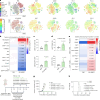Potentiating cancer immunotherapies with modular albumin-hitchhiking nanobody-STING agonist conjugates
- PMID: 40500332
- PMCID: PMC12532571
- DOI: 10.1038/s41551-025-01400-0
Potentiating cancer immunotherapies with modular albumin-hitchhiking nanobody-STING agonist conjugates
Abstract
The enhancement of antitumour immunity via agonists of the stimulator of interferon genes (STING) pathway is limited by pharmacological barriers. Here we show that the covalent conjugation of a STING agonist to anti-albumin nanobodies via site-selective bioconjugation chemistries prolongs the circulation of the agonist in the blood and increases its accumulation in tumour tissue, stimulating innate immune programmes that increased the infiltration of activated natural killer cells and T cells, which potently inhibited the growth of mouse tumours. The technology is modular, as demonstrated by the recombinant integration of a second nanobody domain targeting programmed death-ligand 1 (PD-L1), which further increased the accumulation of the agonist in tumours while blocking immunosuppressive PD-1/PD-L1 interactions. The bivalent nanobody-STING agonist conjugate stimulated robust antigen-specific T-cell responses and long-lasting immunological memory and conferred enhanced therapeutic efficacy. It was also effective as a neoadjuvant treatment to adoptive T-cell therapy. As a modular approach, hitchhiking STING agonists on serum albumin may serve as a broadly applicable strategy for augmenting the potency of systemically administered cancer immunotherapies.
© 2025. The Author(s).
Conflict of interest statement
Competing interests: J.T.W., K.A. and B.R.K. are inventors on United States Patent Application PCT/US2023/079884 ‘NANOBODY-DRUG CONJUGATES AND METHODS OF PREPARING THEREOF’ which describes nanobody conjugation and delivery technologies. J.T.W. has received research support from Incyte Corporation within the past 3 years. J.C.R. is an employee of Vanderbilt University Medical Center and appointed to the Vanderbilt University School of Medicine. He is a scientific advisory board member of Sitryx Therapeutics. J.C.M. and J.A.M. received support from Agilent Technologies in the form of a Thought Leader Award. Agilent is a commercial manufacturer of the MS instrumentation used in aspects of this work. J.A.M. is a member of the Scientific Advisory Board for MOBILion Systems, which is a manufacturer of high-resolution ion mobility–MS instrumentation. J.A.M. certifies that his contributions are scientifically objective and not influenced by his Scientific Advisory Board participation. J.M.B. receives research support from Genentech/Roche and Incyte Corporation, has received advisory board payments from AstraZeneca, Eli Lilly and Mallinckrodt and is an inventor on patents regarding immunotherapy targets and biomarkers in cancer.
Figures


















Update of
-
Programable Albumin-Hitchhiking Nanobodies Enhance the Delivery of STING Agonists to Potentiate Cancer Immunotherapy.Res Sq [Preprint]. 2024 May 8:rs.3.rs-3243545. doi: 10.21203/rs.3.rs-3243545/v1. Res Sq. 2024. Update in: Nat Biomed Eng. 2025 Oct;9(10):1719-1739. doi: 10.1038/s41551-025-01400-0. PMID: 38766114 Free PMC article. Updated. Preprint.
References
-
- Sharma, P. et al. The next decade of immune checkpoint therapy. Cancer Discov.11, 838–857 (2021). - PubMed
-
- Galon, J. & Bruni, D. Approaches to treat immune hot, altered and cold tumours with combination immunotherapies. Nat. Rev. Drug Discov.18, 197–218 (2019). - PubMed
-
- Demaria, O. et al. Harnessing innate immunity in cancer therapy. Nature574, 45–56 (2019). - PubMed
MeSH terms
Substances
Grants and funding
- R01 CA11601/U.S. Department of Health & Human Services | NIH | National Cancer Institute (NCI)
- I01 BX002301/BX/BLRD VA/United States
- IK6B005225/U.S. Department of Veterans Affairs (Department of Veterans Affairs)
- 193793/National Science Foundation (NSF)
- Postdoctoral Fellowship in Drug Delivery/Pharmaceutical Research and Manufacturers of America Foundation (PhRMA Foundation)
- S10 OD021630/OD/NIH HHS/United States
- P30 EY008126/EY/NEI NIH HHS/United States
- SPORE 2P50CA098131-17/U.S. Department of Health & Human Services | NIH | National Cancer Institute (NCI)
- R01 CA266767/CA/NCI NIH HHS/United States
- T32DK101003/U.S. Department of Health & Human Services | NIH | National Institute of Diabetes and Digestive and Kidney Diseases (National Institute of Diabetes & Digestive & Kidney Diseases)
- CCR19609205/Susan G. Komen (Susan G. Komen Breast Cancer Foundation)
- R01 CA274675/CA/NCI NIH HHS/United States
- K00 CA253718/CA/NCI NIH HHS/United States
- P30 DK058404/DK/NIDDK NIH HHS/United States
- F32 CA288044/CA/NCI NIH HHS/United States
- R01 CA245134/CA/NCI NIH HHS/United States
- BC170037/United States Department of Defense | United States Army | Army Medical Command | Congressionally Directed Medical Research Programs (CDMRP)
- T32CA009592/U.S. Department of Health & Human Services | NIH | National Cancer Institute (NCI)
- P50 CA098131/CA/NCI NIH HHS/United States
- T32 DK101003/DK/NIDDK NIH HHS/United States
- T32GM007347/U.S. Department of Health & Human Services | NIH | National Institute of General Medical Sciences (NIGMS)
- T32 GM007347/GM/NIGMS NIH HHS/United States
- P30 DK020593/DK/NIDDK NIH HHS/United States
- P30 CA068485/CA/NCI NIH HHS/United States
- T32 GM065086/GM/NIGMS NIH HHS/United States
- P30 CA68485/U.S. Department of Health & Human Services | NIH | National Cancer Institute (NCI)
- T32 CA009592/CA/NCI NIH HHS/United States
- CBET-1554623/National Science Foundation (NSF)
- R01 CA217987/CA/NCI NIH HHS/United States
- T32GM065086/U.S. Department of Health & Human Services | NIH | National Institute of General Medical Sciences (NIGMS)
- U24 DK059637/DK/NIDDK NIH HHS/United States
- DMR 1852157/National Science Foundation (NSF)
LinkOut - more resources
Full Text Sources
Medical
Research Materials

